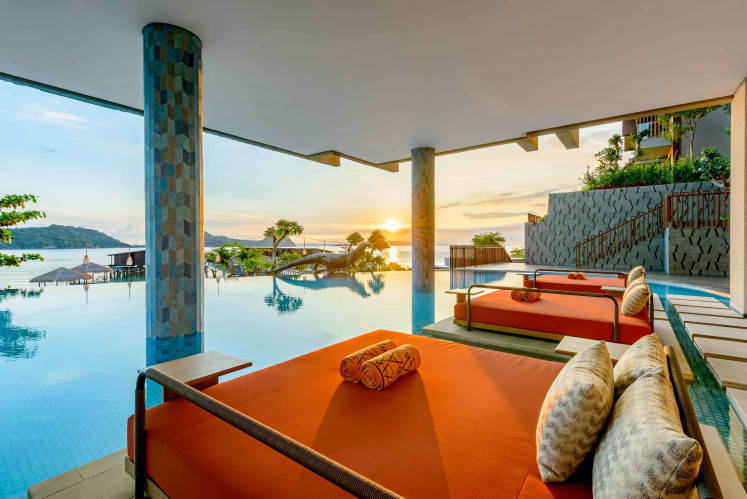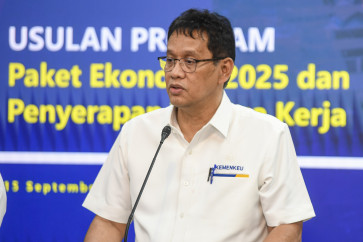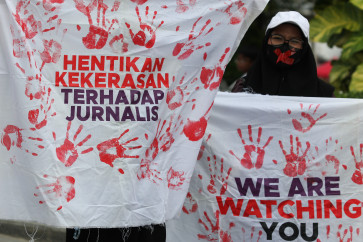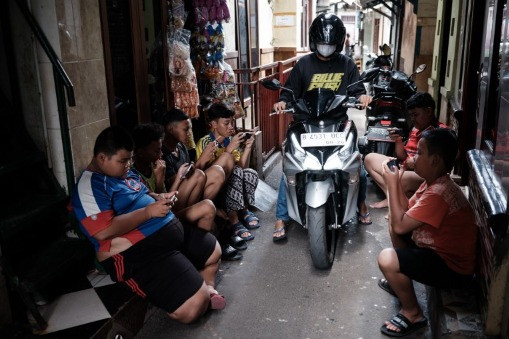Popular Reads
Top Results
Can't find what you're looking for?
View all search resultsPopular Reads
Top Results
Can't find what you're looking for?
View all search resultsChris Suharso: The watercolor maestro of Bali on display
Sembahyang (1996) (Harry Nazarudin )Many know master Indonesian painters such as Basuki Abdullah and Affandi
Change text size
Gift Premium Articles
to Anyone
 Sembahyang (1996) (Harry Nazarudin )" border="0" height="711" width="511">Sembahyang (1996) (Harry Nazarudin )
Sembahyang (1996) (Harry Nazarudin )" border="0" height="711" width="511">Sembahyang (1996) (Harry Nazarudin )Many know master Indonesian painters such as Basuki Abdullah and Affandi.
Few, however, remember Chris Suharso, an Indonesian-Chinese master artist whose works are currently on display at an exhibition titled âThe Tranquil Worldâ at the Art:1 New Museum in Jakarta.
Art expert Agus Dermawan T .said that there has been a long-standing tendency to view Chinese Indonesians as traders and not art producers.
However, after the nation gained independence in 1945, Chinese Indonesian artists flourished as part of a new, nationalistic movement in art that peaked in 1955, when Lee Man Fong founded the Yin Hua arts association.
Located in Lokasari in North Jakarta, Yin Hua was a place full of Chinese and pribumi (ânativeâ, or non-Chinese Indonesian) artists, working together to define the nation artistically.
Two relatives were prominent in the association: Siauw Tik Kwie (Otto Suastika), who drew one of Indonesiaâs first comic strips, Si Djin Kui, for the Star Weekly, in the 1950s, and Siauw Swie Tjhing (later known as Chris Suharso), who became a watercolor master.
 Sembahyang (1996)<)
Sembahyang (1996)<)
S
span class="caption">Sembahyang (1996) (Harry Nazarudin )
Many know master Indonesian painters such as Basuki Abdullah and Affandi.
Few, however, remember Chris Suharso, an Indonesian-Chinese master artist whose works are currently on display at an exhibition titled 'The Tranquil World' at the Art:1 New Museum in Jakarta.
Art expert Agus Dermawan T .said that there has been a long-standing tendency to view Chinese Indonesians as traders and not art producers.
However, after the nation gained independence in 1945, Chinese Indonesian artists flourished as part of a new, nationalistic movement in art that peaked in 1955, when Lee Man Fong founded the Yin Hua arts association.
Located in Lokasari in North Jakarta, Yin Hua was a place full of Chinese and pribumi ('native', or non-Chinese Indonesian) artists, working together to define the nation artistically.
Two relatives were prominent in the association: Siauw Tik Kwie (Otto Suastika), who drew one of Indonesia's first comic strips, Si Djin Kui, for the Star Weekly, in the 1950s, and Siauw Swie Tjhing (later known as Chris Suharso), who became a watercolor master.
At work: Chris Suharso paints a mural at Hotel Indonesia in this undated photo. (Courtesy of The Tranquil World)
Suharso's path was not easy after Chinese Indonesians were persecuted after the rise of the New Order in 1966.
Chinese characters were banned, Yin Hua disintegrated, several artists fled to Singapore, and Suharso, now with a family, had to work in various companies to earn money ' all while struggling to make art.
Between 1966 and 1977, Chris had to work outside his studio. 'It was a difficult time financially for our family' said Adjiwibowo Suharso, Suharso' son.
By 1984, Suharso could focus exclusively on painting, finding his true calling in painting watercolors of Bali's scenery.
He had been visiting the island since 1961, staying at his favorite place, the Mumbul Inn in Ubud, and mingling with renown local artists such as Antonio Blanco and Arie Smit.
In Bali, Suharso would take many photographs to inspire his work after returning home and produced large watercolor works such as Odalan in 1989.
The exhibition shows how Suharso began as a mixed-media artist, flipping between watercolors and oil, perhaps settling on the former due to its similarities to traditional Chinese ink paintings, which deemphasized color in favor of shading and lighting
His love for Balinese landscape and watercolor carried on, peaking in the 1990s, as is evident in the 1997 work Pura di Pedalaman (Pura in the Wilderness), which depicts a Balinese Hindu temple.
The detailed depiction of the pura, framed by thick forest and banana tree, gives a sense of elegant tranquility, especially through rays of light made by using water to dilute colors.
Island of the Gods: By 1984, Suharso could focus exclusively on painting, finding his true calling in painting watercolors of Bali's scenery.
His Pasar Antik (Antiques Market, 1998) was made when Suharso was 67 years old and suffering from the cancer that would claim his life by 1999.
The painting shows no weakness. It is vibrant, made with the energy of a teenager, showing the intricate details of an antique shop, with intelligent lighting and strong impression. The same can be seen in Tari Pandan (1996).
To close the exhibition, on the left side of the exit door, there is a picture of a man in his 60s, happily smiling while wearing a complete Balinese attire with sarong and head dress, sitting in front of a beautiful Balinese door.
This is Suharso, photographed in front of his studio in Jakarta, after finding peace in Bali and a welcome reception as an artist.
The exhibition of Suharso's works at the Art:1 New Museum in Central Jakarta closes on Sep. 27.











